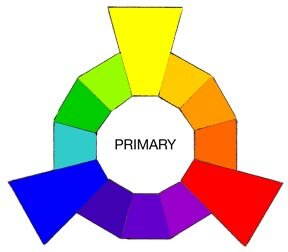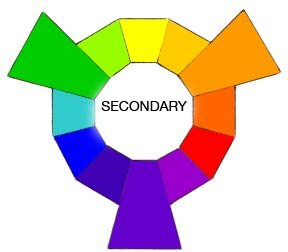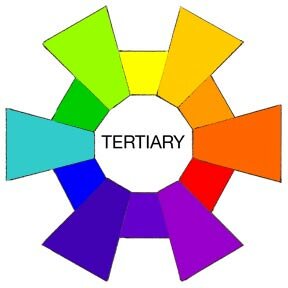What are Primary Colors plus…
Secondary & Tertiary In-Betweens ?
Before discussing Primary Colors with their Secondary and Tertiary mixtures, there is one very important thing to keep in mind.
Light through a prism mixes a little differently than solid paint. Because digital colors are mixed with light, there are different systems used. The printing industry also uses a different color system called CMYK. There will be more on this later.
To keep things simple for now, this page focuses on paint mixtures only. In other words what happens when one tangible hue is physically mixed with another.
Primary Colors

In theory, the Primary Colors are the root of every other hue imaginable. The primary pigments used in the manufacture of paint come from the pure source element of that Hue. There are no other pigments blended in to alter the formula.
Think of the three Primaries as the Parents in the family of colors.
In paint pigments, pure Yellow, pure Red, and pure Blue are the only hues that can’t be created by mixing any other colors together. Printer inks and digital primaries are referred to as Yellow, Magenta and Cyan.
Secondary Colors

When you combine any two of the Pure Primary Hues, you get three new mixtures called Secondary Colors.
Think of the three Secondaries as the Children in the family of colors.
Yellow + Red = ORANGE
Red + Blue = VIOLET or PURPLE
Blue + Yellow = GREEN
Tertiary Colors

When you mix a Primary and its nearest Secondary on the Basic Color Wheel you createsix new mixtures called Tertiary colors.
Think of the six Tertiary Colors as the Grandchildren in the family of colors, since their genetic makeup combines a Primary and Secondary color.
Yellow + Orange = YELLOW-ORANGE
Red + Orange = RED-ORANGE
Red + Violet = RED-VIOLET
Blue + Violet = BLUE-VIOLET
Blue + Green = BLUE-GREEN
Yellow + Green = YELLOW-GREEN
This totals twelve basic colors that allows you to mix an endless variety of hues, tints, tones and shades.
Most artists don’t actually mix every color themselves from scratch. It’s far simpler to work with astandard palette of six or twelve pre-mixed paint tubes. Just keep them as pure and unmixed as possible.
Try this for fun !!
If you’re just learning about how colors interact, start with three Primary Colors and mix your own Basic Color Wheel. Try and duplicate it yourself. Don’t worry if it doesn’t look the same because the different Red, Yellow and Blue pigments on the market will give you slightly different results.
The experience of actually using the Primaries to mix the Secondarys and Tertiaries yourself from scratch will help you understand subtleties of color much more profoundly.
1. Download the first and second Free Printable Color Wheels to practice on.
2. Print out several of the second free template on standard white 8 1/2″ x 11″ paper.
3. Get ready your Red, Yellow and Blue paints. Keep it simple like watercolor, poster paints or acrylic.
4. First, paint in the Primary Colors in their spots on the mixing wheel, right from the tube or bottle.
5. Next, Mix the Secondary colors yourself and try to get as close as possible to the Color Wheel reference as you can. It’s good practice to see how they blend together.
6. Now try mixing the Tertiary Colors using the three Primary colors plus your mixtures of Secondary Colors.
7. It’s always a good idea to make notes about the mixtures that you like. Keep all your paint mixtures as painting reference. Yes, even the ones you think are mistakes. That’s how you learn.
What’s next ? How do you tone things down ?
Now that you’ve mixed these 12 basic bold Hues, you can begin to refine them.
Download Free Color Wheels Practice mixing colors !

